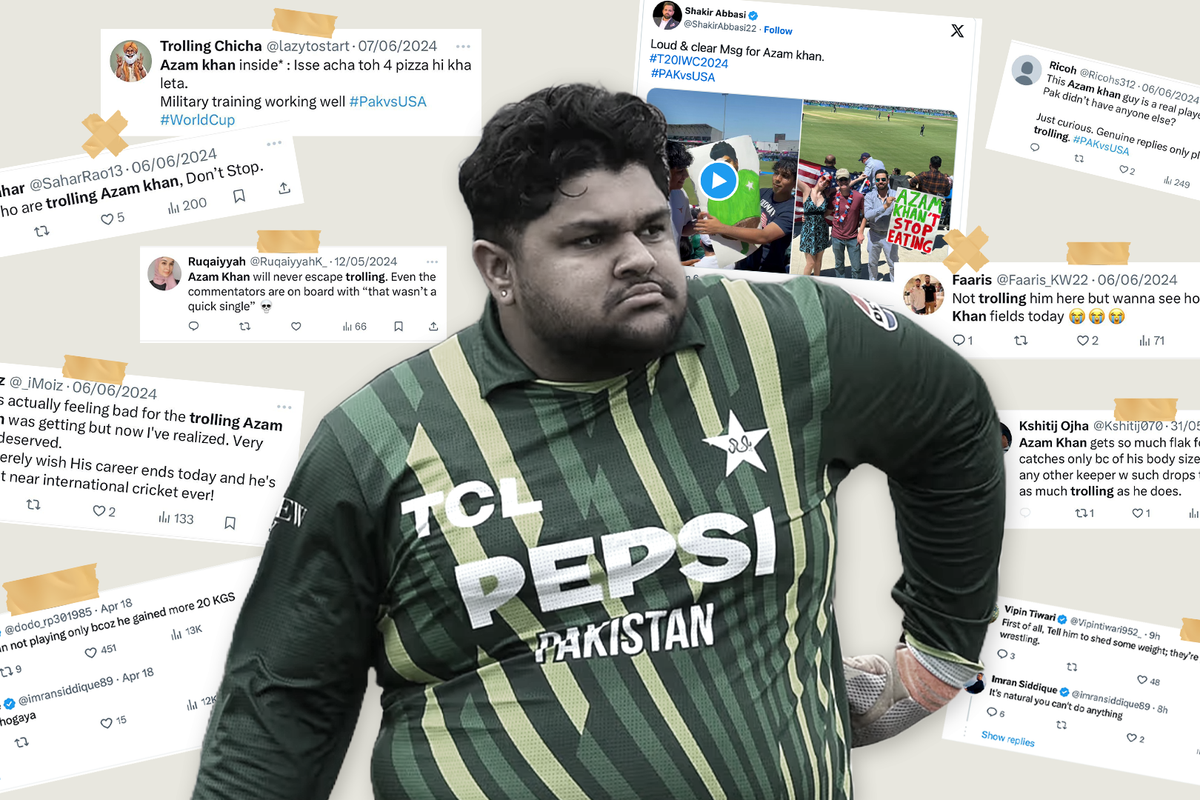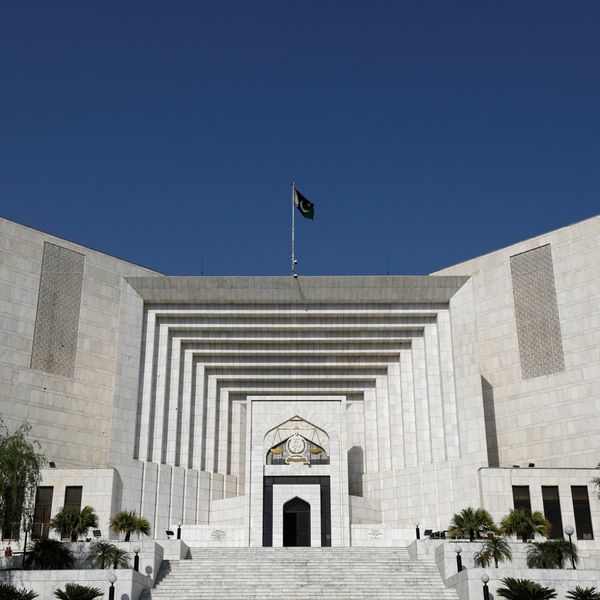Body Shaming in Sports: Is Azam Khan Fair Game?
Moin Khan’s son has been on the receiving end of some harsh, often abusive, criticism. The question remains – is he a good fit for the team?

Design by Ali Naqvi
Sports crowds can be an unforgiving lot. And Pakistani cricket fans are certainly no exception. We may have the occasional devastating loss on the field, but our social media game is unbeatable.
While Pakistani cricket fans’ subsequent memes are often * chef’s kiss* stellar, there comes a point when the line between lighthearted banter and hurtful ridicule blurs, as witnessed in the recent body shaming directed at cricketer Azam Khan.
Azam found himself thrust into the limelight following a series of challenging performances on the cricket field. He was dismissed for a golden duck in Pakistan's T20 World Cup 2024 opener against the USA on June 6.
What should have been a moment for constructive criticism towards his fitness levels as an athlete quickly spiraled into a deluge of derogatory comments and hurtful taunts directed at his physical appearance. The conversation should have centered around specific areas for improvement in Azam's athletic abilities, such as endurance, agility, and strength. However, from comments about his weight to jabs at his physique, Azam found himself at the receiving end of relentless body shaming on social media, even by his own captain.
But some critics argue that there is legitimacy in their concerns and at the end of the day, the question remains: Can Azam Khan contribute meaningfully to the team?
‘Nepo Baby’ Allegations
Azam’s struggles on the field may indeed warrant scrutiny, but focusing solely on his appearance overshadows legitimate concerns about his contributions to the team. Moreover, considering the legacy he comes from adds further nuance to the situation.
With his entry into professional cricket at the age of 20, playing in the Pakistan Super League (PSL), Azam found himself ensnared in debates surrounding nepotism (his father is former Pakistan cricket captain Moin Khan). One could argue he’s an easy target – a ‘nepo baby’ who doesn’t meet societal expectations of athleticism and physical appearance.
In a 2023 interview, Azam told Cricket Monthly: “People will always judge me because my father has played for Pakistan but it's not my fault I was born at his house. But after I got my chance in the PSL, people criticised me because I was overweight and said my body is not suited for the elite game [level] of cricket.”
While it's natural for the offspring of a cricketing legend to attract attention, questions arise about whether Azam's selection is solely based on merit or if there are other factors at play. There have been persistent murmurs about the level of Moin Khan's influence in Azam's selection for various teams, including the national squad. However, it's crucial to assess Azam's contribution to the team objectively. While his lineage may have opened doors for him, his performance on the field ultimately determines his worth as a player. It's essential to separate discussions about nepotism from discussions about his athletic capabilities, allowing for a fair assessment of his place in the team. Nepotism in sports isn’t like nepotism in the entertainment industry، for example. In sports, meritocracy prevails, backed by statistics (more on that later.)
A Lack of Experience
Criticism against Azam was exacerbated more recently by his underwhelming performance in the World Cup opener. Detractors pointed to his physique as the cause of his lackluster performance as opposed to his lack of experience.
Former Pakistan captain and wicketkeeper Rashid Latif defended Azam, telling The Indian Express: “He is under immense pressure. He is being body shamed, is being trolled. Azam is an exceptional batsman in T20s. I feel bad for the kid, he is only 25.” He further stressed that it was Azam’s inexperience, not fitness, that caused him to fumble his World Cup debut.
Cricket fans were less understanding, with one posting a video of Azam eating at a roadside cart in New York after Pakistan’s humiliating defeat. The sighting made many headlines, in fact.
Azam vs Other Players
Another Pakistani cricketer who comes to mind is Inzamamul ‘Inzi’ Haq, a legendary beast of a batsman, often in the spotlight not just for his talent but for his large stature, and his tendency to get run-out often.
During a Test match between Pakistan and India in Toronto in 1997, a spectator taunted Inzamam by calling him “aloo.” In response, Inzamam famously confronted the spectator and was later fined by the match referee. According to reports, the heckler was repeatedly shouting, “ O mote, sidha khara ho [O fatso, stand straight].” The incident became infamous in cricketing lore and highlighted the issue of player abuse and heckling from spectators.
Inzamam was a powerhouse player, renowned for his exceptional batting skills and his ability to make a substantial impact on the game. His career was marked by numerous records and memorable performances that solidified his status as a cricket legend. On the other hand, Azam is still early in his career. Inzamam's legacy was built over decades of consistent performance, whereas Azam is still in the process of proving himself.
It probably makes more sense then to evaluate Azam's potential and contributions alongside other players' contributions to the team. The following chart compares Azam's T20I stats with those of his contemporaries -- cricketers who have similar experience, are of the same age, or play in the same wicketkeeper-batsman position.
While it’s fair to critique Azam’s on-field performance and discuss his position in the team in the context of nepotism, comments about his weight are inappropriate and unfair. Especially when compared to his contemporaries, his stats do not fare well. In that sense, criticism over his skills and contributions to the team hold a lot more weight (pun not intended) than playground fat jokes.
As cricket fans, pundits and supporters, we play a crucial role in shaping a respectful sporting culture. Azam’s performance on the field is what matters and any scrutiny in that respect is what counts. Calling a player ‘ hathi’ or ‘aloo’ is below the belt, mocking their looks is too much and secretly filming them eating is a gross invasion of privacy. Let’s remember that in cricket, the only lines that should be crossed are boundaries.







Comments
See what people are discussing